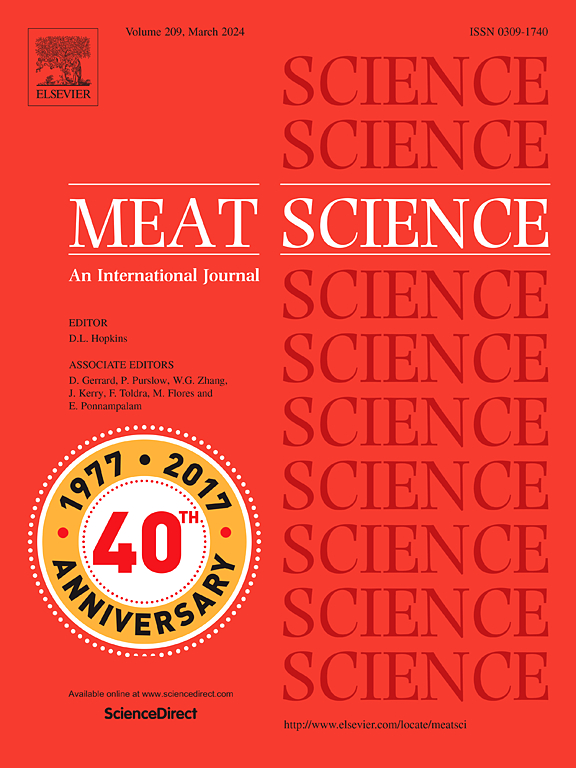Evaluation of the lipolytic and antioxidant activities of different strains of coagulase-negative staphylococci in fermented sausages
IF 6.1
1区 农林科学
Q1 Agricultural and Biological Sciences
引用次数: 0
Abstract
Six strains of coagulase-negative staphylococci, isolated from fermented meat products and identified as Staphylococcus hominis 9, Staphylococcus saprophyticus 18, Staphylococcus saprophyticus 27, Staphylococcus xylosus 37, Staphylococcus saprophyticus 120, and Staphylococcus cohnii 129, were evaluated for their lipid hydrolase and antioxidant enzyme activities. The effects of the selected strains on lipid hydrolysis and oxidation in fermented sausages were subsequently investigated. In meat simulation medium, Staphylococcus cohnii 129 exhibited the highest lipase and superoxide dismutase activities among all tested strains. Therefore, S. cohnii 129 was selected as the optimal strain to ferment sausage either alone (S129) or in combination with Lactiplantibacillus plantarum 77 (S129 + L77), with a blank group as the control. Lipase activities and the concentrations of lipid hydrolysis products, including monoglyceride, free glycerol, and free fatty acids, were higher in both S129 and S129 + L77 than in the control. Additionally, the suppression of lipoxygenase activity, TBARS, hexanal, and saturated aldehyde production was more pronounced in S129 and S129 + L77 compared to the control. Moreover, the highest scores for overall flavor and acceptability, and the lowest score for rancid notes, were reported for S129. The results indicate that S. cohnii 129 has significant potential for improving sausage quality and preventing the formation of off-flavors.
发酵香肠中不同凝固酶阴性葡萄球菌的溶脂和抗氧化活性评价
从发酵肉制品中分离得到6株凝固酶阴性葡萄球菌,鉴定为人型葡萄球菌9、腐生葡萄球菌18、腐生葡萄球菌27、木糖葡萄球菌37、腐生葡萄球菌120和cohnii葡萄球菌129,对其脂质水解酶和抗氧化酶活性进行了测定。随后研究了所选菌株对发酵香肠中脂质水解和氧化的影响。在肉类模拟培养基中,cohni葡萄球菌129的脂肪酶和超氧化物歧化酶活性最高。因此,选择柯氏杆菌129作为单独发酵香肠(S129)或与植物乳杆菌77 (S129 + L77)联合发酵香肠的最佳菌株,并以空白组为对照。脂肪酶活性和脂质水解产物(包括单甘油酯、游离甘油和游离脂肪酸)浓度在S129和S129 + L77中均高于对照组。此外,与对照相比,S129和S129 + L77对脂氧合酶活性、TBARS、己醛和饱和醛产生的抑制更为明显。此外,总体风味和可接受性得分最高,腐臭音符得分最低的是S129。结果表明,大肠杆菌129在改善香肠品质和防止异味形成方面具有较大的潜力。
本文章由计算机程序翻译,如有差异,请以英文原文为准。
求助全文
约1分钟内获得全文
求助全文
来源期刊

Meat Science
工程技术-食品科技
CiteScore
12.60
自引率
9.90%
发文量
282
审稿时长
60 days
期刊介绍:
The aim of Meat Science is to serve as a suitable platform for the dissemination of interdisciplinary and international knowledge on all factors influencing the properties of meat. While the journal primarily focuses on the flesh of mammals, contributions related to poultry will be considered if they enhance the overall understanding of the relationship between muscle nature and meat quality post mortem. Additionally, papers on large birds (e.g., emus, ostriches) as well as wild-captured mammals and crocodiles will be welcomed.
 求助内容:
求助内容: 应助结果提醒方式:
应助结果提醒方式:


